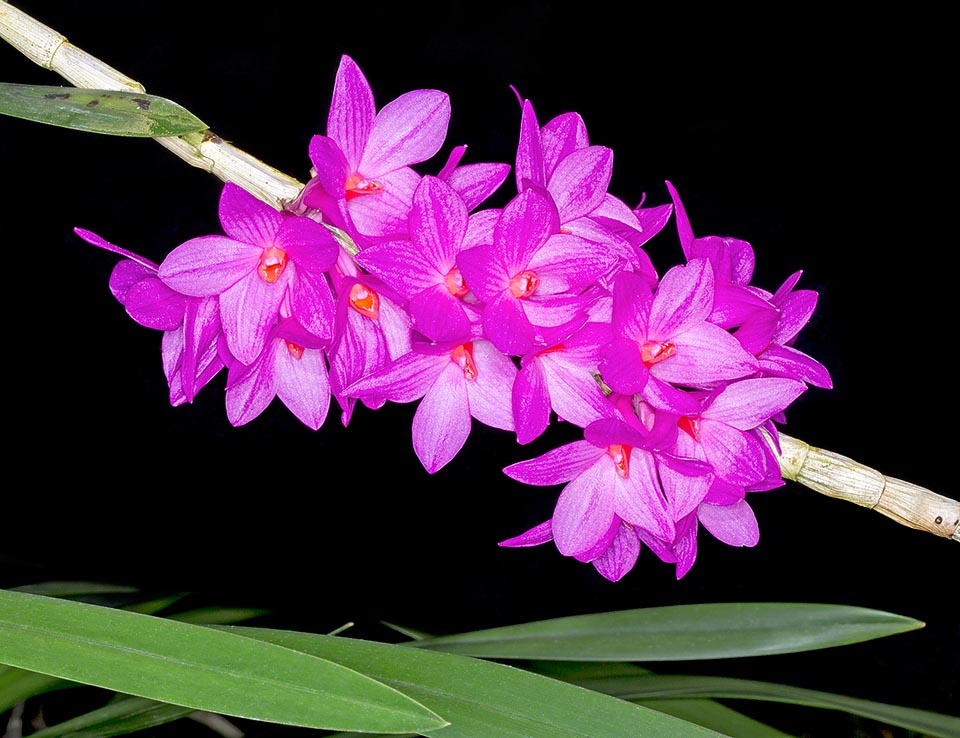Family : Orchidaceae

Text © Pietro Puccio

English translation by Mario Beltramini
The species is native to the Moluccas and Sulawesi where it grows on the trees of the humid forests between 1200 and 1500 m of altitude.
The name of the genus is the combination of the Greek substantives “δένδρον” (dendron) = tree and “βίος” (bios) = life, with reference to the numerous species of the genus living on the trees; the specific name is the Latin adjective “glomeratus, a, um” = agglomerated, grouped, with reference to the dense inflorescences.
The Dendrobium glomeratum Rolfe (1894) is an epiphytic species with drooping cylindrical pseudobulbs, 0,6-1 m long and of about 1 cm of diameter at the most, provided of deciduous leaves for almost their length. Elliptical-lanceolate leaves with acute apex, 5-10 cm long and 1,5-3 cm broad, of intense green colour, coriaceous. Sessile inflorescences in dense racemes, from the axils of the upper half of the pseudobulbs of the previous years without leaves, with 3-10 long lasting flowers, about one month, with intense purple pink coloured sepals and petals, luminous, with darker longitudinal striations, and orange labellum, of 4-6 cm of diameter. Elliptical dorsal sepal with obtuse apex, 2-3,5 cm long and 1-1,5 cm broad, ovate-triangular lateral sepals with obtuse apex, 2,5-3 cm long and 1,5 cm broad, united at the base to form a conical spur (mentum) with obtuse apex 1,8-2 cm long. Obovate-elliptical petals with obtuse apex, 2,2-2,8 cm long and 1-1,5 cm broad, almost saccate labellum with eroded-toothed margin, 0,8-2 cm long and 0,6-0,8 cm broad, and about 0,5 cm long column; pedicel and ovary 2,5-3 cm long.

Native to Moluccas and Sulawesi, Dendrobium glomeratum is an epiphyte with drooping 60-100 cm pseudobulbs. The showy inflorescences last even one month © Giuseppe Mazza
Floriferous species with bright colours, very much appreciated by the collectors, requires a slightly shaded and aerated position, intermediate temperatures, 20-30 °C, with lowest winter values not under the 14 °C, a sensible daily thermal excursion and high humidity, 80-90 %. Regular and abundant waterings during the growth phase, more spaced in winter, but without ever allowing the substratum to dry up completely, utilizing rain water, demineralized or by reverse osmosis. Monthly fertilizations, from spring to autumn, utilizing a specific product of orchids diluted at 50 % in respect to the dosage shown on the package. Due to the drooping posture is to be cultivated in suspended pots or baskets, unless predisposing suitable supports, with compost based of medium sliced bark fragments, or mounted on bark or raft with sphagnum at the base to maintain the humidity. The repottings are to be done at the vegetative restart when the compost gives clear signs of deterioration and of loss ot the draining properties.
The species is reported in the appendix II of the CITES (species whose trade is internationally ruled).
Synonyms: Dendrobium crepidiferum J.J.Sm. (1922); Pedilonum crepidiferum (J.J.Sm.) Rauschert (1983); Pedilonum glomeratum (Rolfe) Rauschert (1983); Dendrobium sulawesiense Erfkamp & O.Gruss (2000); Chromatotriccum crepidiferum (J.J.Sm.) M.A.Clem. & D.L.Jones (2002); Chromatotriccum sulawesiense (Erfkamp & O.Gruss) M.A.Clem. & D.L.Jones (2002); Coelandria glomerata (Rolfe) M.A.Clem. (2003).
→ For general notions about ORCHIDACEAE please click here.
